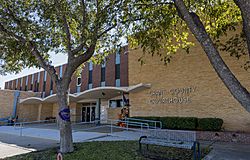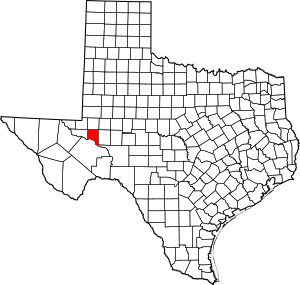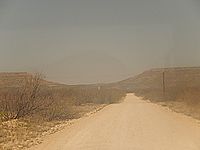Crane County, Texas facts for kids
Quick facts for kids
Crane County
|
|
|---|---|

Crane County Courthouse in Crane
|
|

Location within the U.S. state of Texas
|
|
 Texas's location within the U.S. |
|
| Country | |
| State | |
| Founded | 1927 |
| Named for | William Carey Crane |
| Seat | Crane |
| Largest city | Crane |
| Area | |
| • Total | 786 sq mi (2,040 km2) |
| • Land | 785 sq mi (2,030 km2) |
| • Water | 0.7 sq mi (2 km2) 0.08% |
| Population
(2020)
|
|
| • Total | 4,675 |
| • Density | 5.948/sq mi (2.2965/km2) |
| Time zone | UTC−6 (Central) |
| • Summer (DST) | UTC−5 (CDT) |
| Congressional district | 23rd |
Crane County is a county located in the U.S. state of Texas. As of the 2020 census, its population was 4,675. The county seat is Crane. The county was created in 1887 and later organized in 1927. It was named for William Carey Crane, a president of Southern Baptist-affiliated Baylor University in Waco, Texas.
Contents
History
Native Americans
Indigenous peoples were the first inhabitants of the area. Later Indian tribes included Comanches, Lipan Apache, and Kiowa.
County establishment and growth
Crane County was formed in 1887 from Tom Green County, and named after William Carey Crane, former president of Baylor University. Settlement came years later, and the county was not organized until 1927. In 1900, the United States census enumerated only 51 people and 12 ranches in the county. As late as 1918, the county had no roads.
In 1925, Church & Fields Exploration Company obtained a permit late in 1925 to drill for oil. The first well came in March 1926.
By 1927, an estimated 6,000 people were in the county, with 4,500 of them within the city of Crane. Water was trucked in and brought from $1.00 to $2.25 a barrel. By the beginning of 1991, almost 1,552,324,000 barrels (246,799,800 m3) of oil had been produced in the county since discovery in 1926.
County history is preserved in the Museum of the Desert Southwest, which opened in Crane in 1980.
Geography
According to the U.S. Census Bureau, the county has a total area of 786 square miles (2,040 km2), of which 785 square miles (2,030 km2) is land and 0.7 square miles (1.8 km2) (0.08%) is water.
Between Crane and McCamey in neighboring Upton County is a division of the surrounding cliffs known as Castle Gap, a break in a mesa some 12 miles east of the Pecos River, used by Comanches, emigrants headed to the California Gold Rush, and cattlemen driving longhorns on the Goodnight-Loving Trail, as explained in Patrick Dearen's Castle Gap and the Pecos Frontier (2000).
Major highways
Adjacent counties
- Ector County (north)
- Upton County (east)
- Crockett County (southeast)
- Pecos County (south)
- Ward County (west)
Demographics
| Historical population | |||
|---|---|---|---|
| Census | Pop. | %± | |
| 1890 | 15 | — | |
| 1900 | 51 | 240.0% | |
| 1910 | 331 | 549.0% | |
| 1920 | 37 | −88.8% | |
| 1930 | 2,221 | 5,902.7% | |
| 1940 | 2,841 | 27.9% | |
| 1950 | 3,965 | 39.6% | |
| 1960 | 4,699 | 18.5% | |
| 1970 | 4,172 | −11.2% | |
| 1980 | 4,600 | 10.3% | |
| 1990 | 4,652 | 1.1% | |
| 2000 | 3,996 | −14.1% | |
| 2010 | 4,375 | 9.5% | |
| 2020 | 4,675 | 6.9% | |
| U.S. Decennial Census 1850–2010 2010 2020 |
|||
2020 census
| Race / Ethnicity | Pop 2010 | Pop 2020 | % 2010 | % 2020 |
|---|---|---|---|---|
| White alone (NH) | 1,761 | 1,342 | 40.25% | 28.71% |
| Black or African American alone (NH) | 122 | 70 | 2.79% | 1.50% |
| Native American or Alaska Native alone (NH) | 34 | 14 | 0.78% | 0.30% |
| Asian alone (NH) | 13 | 22 | 0.30% | 0.47% |
| Pacific Islander alone (NH) | 0 | 0 | 0.00% | 0.00% |
| Some Other Race alone (NH) | 10 | 1 | 0.23% | 0.02% |
| Mixed Race/Multi-Racial (NH) | 26 | 68 | 0.59% | 1.45% |
| Hispanic or Latino (any race) | 2,409 | 3,158 | 55.06% | 67.55% |
| Total | 4,375 | 4,675 | 100.00% | 100.00% |
Note: the US Census treats Hispanic/Latino as an ethnic category. This table excludes Latinos from the racial categories and assigns them to a separate category. Hispanics/Latinos can be of any race.
Communities
City
- Crane (county seat)
Unincorporated community
- Crane County from the Handbook of Texas Online
 |
Ector County |  |
||
| Ward County | Upton County | |||
| Pecos County | Crockett County |
Economy
The largest segment of the local economy is oil and gas production. The Waddell Ranch contains the single biggest portion of the Permian Basin Royalty Trust, with over 800 producing oil wells as of 2007. Crane County is one of the largest oil-producing counties in Texas, with a total of 1.5 billion barrels (240,000,000 m3) of oil pumped since oil was first discovered there. Cattle ranching and local government are other large employers; over 503,000 acres (2,040 km2) of land are used for livestock grazing.
See also
 In Spanish: Condado de Crane para niños
In Spanish: Condado de Crane para niños



